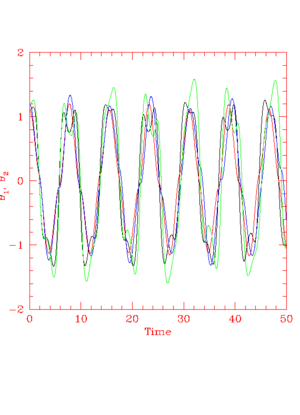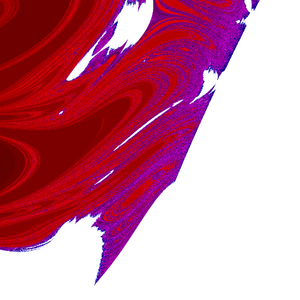Course:PHYS350/Double Pendulum
Back to Chaotic Motion.
Check out the Double Pendulum Fractal Explorer and an article about the double pendulum: File:Double.pdf.
We need at least two degrees of freedom to have a chaotic system. We have integrated several systems with two or more degrees of freedom: planetary orbits, two-dimensional harmonic oscillators, coupled oscillators. Because we solved them they probably don't exhibit chaotic motion. How about the double pendulum?
It turns out that the simple double pendulum is pathological, so we will have to be a bit more sophisticated in our modelling of this system. Specifically, let's imagine we have two thin rods () connected by a pivot and the end of one rod suspended from a pivot.
It is natural to define the coordinates to be the angle between each rod and the vertical. We will denote this by θ1 and θ2. We can write the position of the centre of mass of the two rods in terms of these coordinates. We have
and
This is enough information to write out the Lagrangian.
Lagrangian
The Lagrangian is given by where we have taken the kinetic energy to be sum of the kinetic energy of the centre of mass of each rod and the kinetic energy about the centres of mass of the rods. The potential energy of a body in a uniform gravitational field is given by the potential energy at the centre of mass.
Plugging in the coordinates above and doing a bit of algebra gives
Before we get the equations of motion, we find that there is only one conserved quantity (the energy), and no conserved momenta. We can write the two momenta as
and
Let's invert these expressions to get
and
We can write the remaining equations of motion as
and
Poincaré Plot
Often one has to look at a system for a really long time before its chaotic nature becomes evident. Furthermore, phase space has a lot of dimensions to it so it is quite hard to visualize what is happen. Henri Poincaré devised a neat way to study trajectories through phase space. Define a region in phase space and plot where the trajectory intersects the region, and finally project the region onto a plane.
In the case of the pendulum we are going to look at the plane for .
To illustrate the onset of chaos, we start will slightly different initial conditions and plot the Poincaré plots for about one thousand oscillations of the system in the Poincaré Gallery.
Fractals
Chaotic motion is intimately connected with fractals. For example, we could plot whether either pendulum flips within a set period of time as a function of the initial conditions to see the general structure of the solutions.
We have plotted along the x-direction, the value of θ1 from -3 to 3 and along the y-direction the value of θ2 from -3 to 3. The colour of each pixel indicates whether either pendulum flips within 10 (green), within 100 (red), 1000 (purple) or 10000 (blue). Those that don't flip within 10000 are plotted white.
The boundary of the central white region is defined in part by energy conservation (see this solution for further details) with the following curve Within the region defined by this curve, that is if it is energetically impossible for either pendulum to flip. Outside this region, the pendulums can flip but this is different from determining when they will flip.







![{\displaystyle L={\frac {1}{6}}ml^{2}\left[{{\dot {\theta }}_{2}}^{2}+4{{\dot {\theta }}_{1}}^{2}+3{{\dot {\theta }}_{1}}{{\dot {\theta }}_{2}}\cos(\theta _{1}-\theta _{2})\right]+{\frac {1}{2}}mgl\left(3\cos \theta _{1}+\cos \theta _{2}\right)}](https://wiki.ubc.ca/api/rest_v1/media/math/render/svg/3848c61e265bdabc6d3be50351732628a42abddc)
![{\displaystyle p_{\theta _{1}}={\frac {\partial L}{\partial {{\dot {\theta }}_{1}}}}={\frac {1}{6}}ml^{2}\left[8{{\dot {\theta }}_{1}}+3{{\dot {\theta }}_{2}}\cos(\theta _{1}-\theta _{2})\right]}](https://wiki.ubc.ca/api/rest_v1/media/math/render/svg/d2a4fc4845f5426164b2db73610af085bccb759b)
![{\displaystyle p_{\theta _{2}}={\frac {\partial L}{\partial {{\dot {\theta }}_{2}}}}={\frac {1}{6}}ml^{2}\left[2{{\dot {\theta }}_{2}}+3{{\dot {\theta }}_{1}}\cos(\theta _{1}-\theta _{2})\right]}](https://wiki.ubc.ca/api/rest_v1/media/math/render/svg/6d9fc5b3e4f5e3db68d4d5cbfa6865e6adb007f6)


![{\displaystyle {{\dot {p}}_{\theta _{1}}}={\frac {\partial L}{\partial \theta _{1}}}=-{\frac {1}{2}}ml^{2}\left[{{\dot {\theta }}_{1}}{{\dot {\theta }}_{2}}\sin(\theta _{1}-\theta _{2})+3{\frac {g}{l}}\sin \theta _{1}\right]}](https://wiki.ubc.ca/api/rest_v1/media/math/render/svg/16f38eb448bacb0f227c67f7f36066301370c0a4)
![{\displaystyle {{\dot {p}}_{\theta _{2}}}={\frac {\partial L}{\partial \theta _{2}}}=-{\frac {1}{2}}ml^{2}\left[-{{\dot {\theta }}_{1}}{{\dot {\theta }}_{2}}\sin(\theta _{1}-\theta _{2})+{\frac {g}{l}}\sin \theta _{2}\right]}](https://wiki.ubc.ca/api/rest_v1/media/math/render/svg/a5ed0fb3767aed2bf0abb52b9ad56d3f9f180688)






